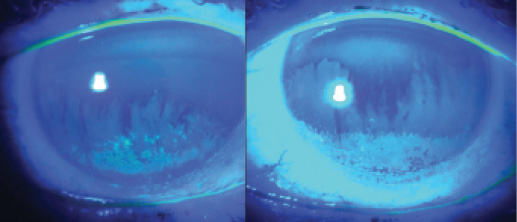This educational supplement is sponsored by Allergan Global Medical Affairs.
All eye care practitioners want to provide their patients the best care possible, and an increasing number recognize that this means paying attention to dry eye. However, not all want to transform into a dry eye specialty center. I love questionnaires as a screening tool because my staff and technicians can administer them to every patient and can decide on their own if the patient needs additional diagnostics. The Ocular Surface Disease Index (OSDI) is now available as an app on your smartphone or tablet (osdiapp.com), making it particularly easy to access.
The next step in dry eye diagnosis is corneal staining with fluorescein to determine tear break-up time (Figure), and then lissamine green for conjunctival staining, followed by examination of the lids at the slit lamp. If all of those things are positive, then we will look at corneal topography and analyze the rings. While I have created a specialty dry eye care center and find value in multiple point-of-service diagnostic tests, these basics are sufficient for a provider that wants to offer comprehensive care.

(Courtesy of William Trattler, MD)
Figure. Punctate staining showing rapid tear break-up time.